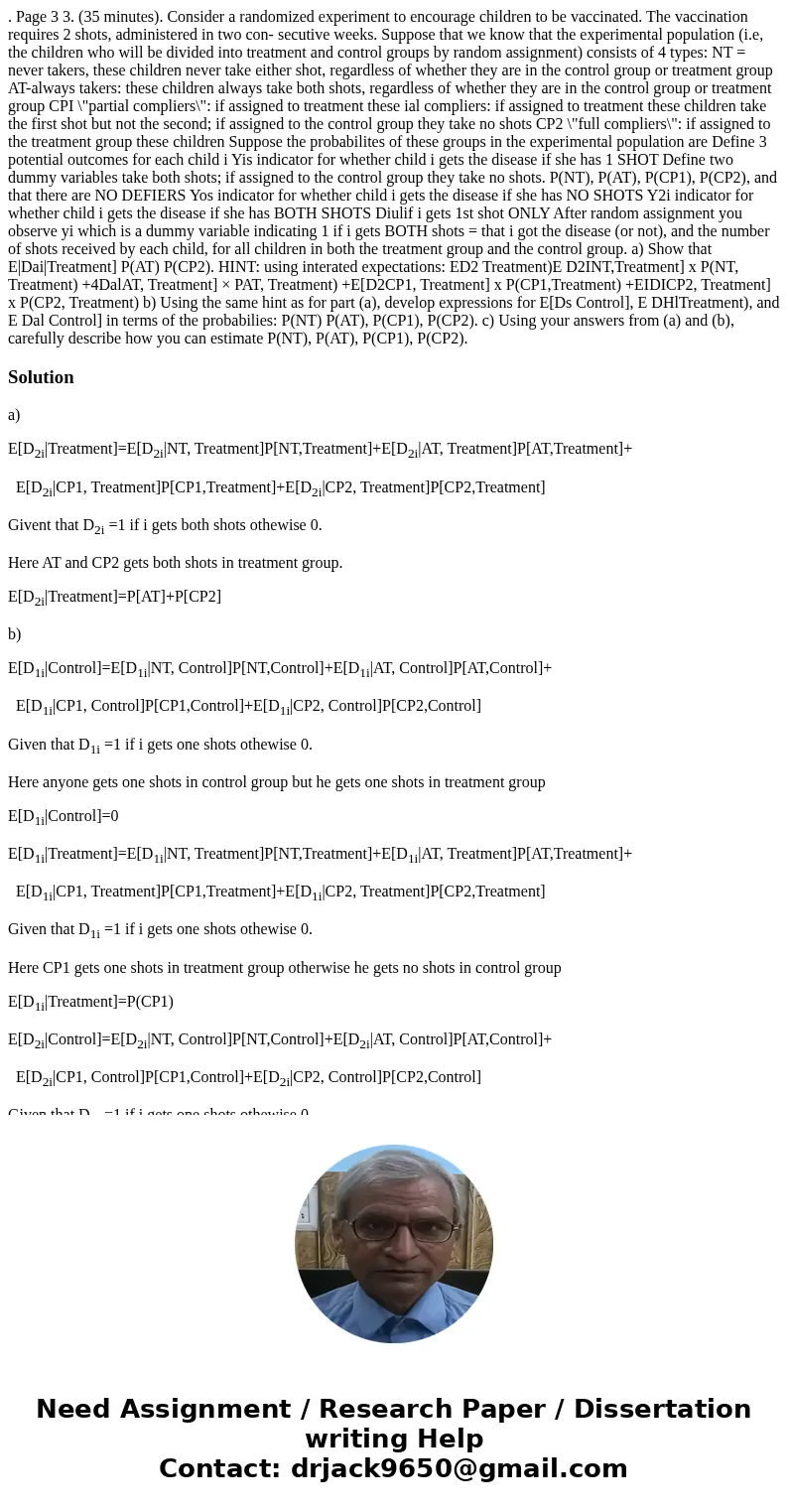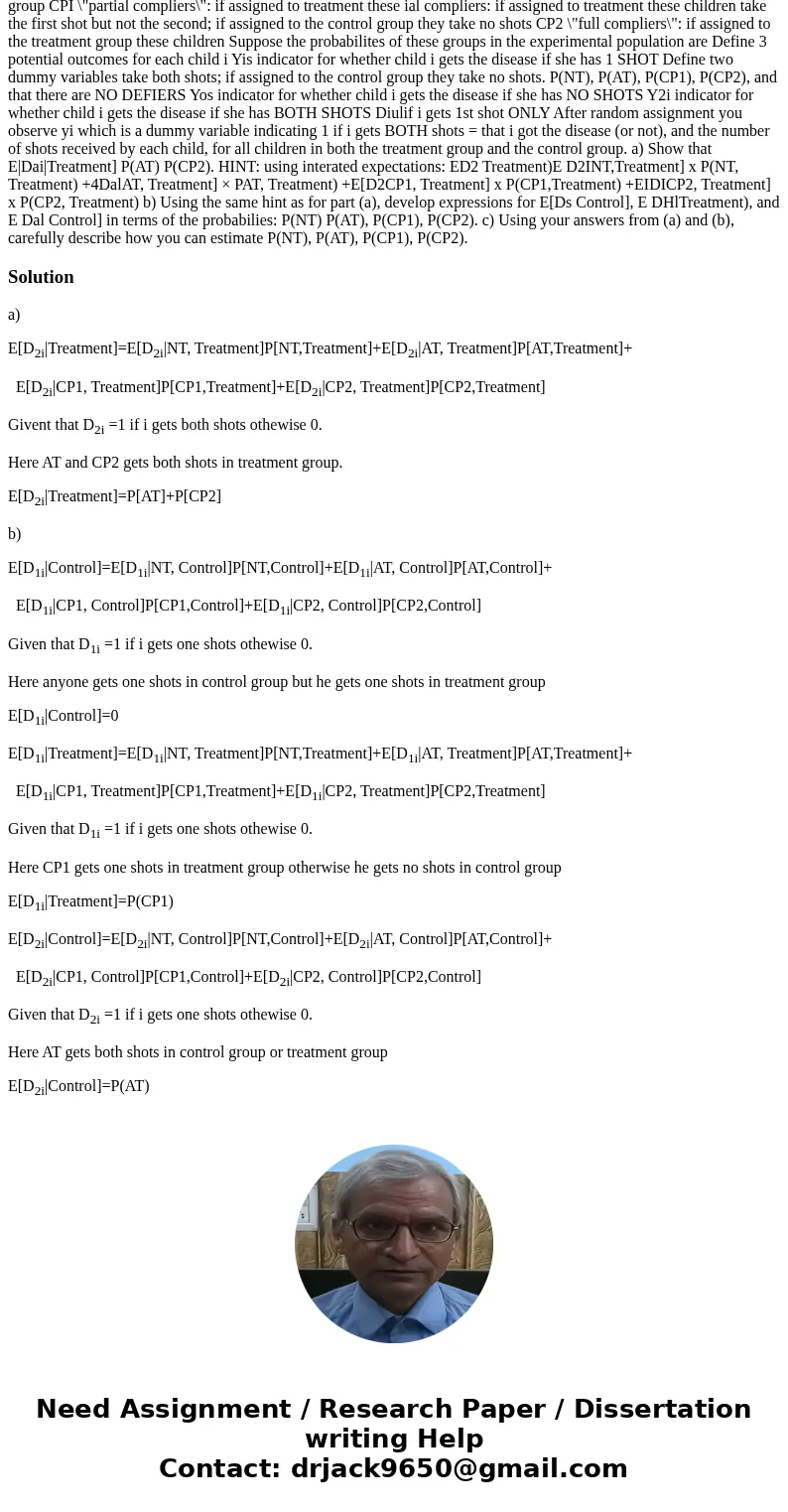. Page 3 3. (35 minutes). Consider a randomized experiment to encourage children to be vaccinated. The vaccination requires 2 shots, administered in two con- secutive weeks. Suppose that we know that the experimental population (i.e, the children who will be divided into treatment and control groups by random assignment) consists of 4 types: NT = never takers, these children never take either shot, regardless of whether they are in the control group or treatment group AT-always takers: these children always take both shots, regardless of whether they are in the control group or treatment group CPI \"partial compliers\": if assigned to treatment these ial compliers: if assigned to treatment these children take the first shot but not the second; if assigned to the control group they take no shots CP2 \"full compliers\": if assigned to the treatment group these children Suppose the probabilites of these groups in the experimental population are Define 3 potential outcomes for each child i Yis indicator for whether child i gets the disease if she has 1 SHOT Define two dummy variables take both shots; if assigned to the control group they take no shots. P(NT), P(AT), P(CP1), P(CP2), and that there are NO DEFIERS Yos indicator for whether child i gets the disease if she has NO SHOTS Y2i indicator for whether child i gets the disease if she has BOTH SHOTS Diulif i gets 1st shot ONLY After random assignment you observe yi which is a dummy variable indicating 1 if i gets BOTH shots = that i got the disease (or not), and the number of shots received by each child, for all children in both the treatment group and the control group. a) Show that E|Dai|Treatment] P(AT) P(CP2). HINT: using interated expectations: ED2 Treatment)E D2INT,Treatment] x P(NT, Treatment) +4DalAT, Treatment] × PAT, Treatment) +E[D2CP1, Treatment] x P(CP1,Treatment) +EIDICP2, Treatment] x P(CP2, Treatment) b) Using the same hint as for part (a), develop expressions for E[Ds Control], E DHlTreatment), and E Dal Control] in terms of the probabilies: P(NT) P(AT), P(CP1), P(CP2). c) Using your answers from (a) and (b), carefully describe how you can estimate P(NT), P(AT), P(CP1), P(CP2).
a)
E[D2i|Treatment]=E[D2i|NT, Treatment]P[NT,Treatment]+E[D2i|AT, Treatment]P[AT,Treatment]+
E[D2i|CP1, Treatment]P[CP1,Treatment]+E[D2i|CP2, Treatment]P[CP2,Treatment]
Givent that D2i =1 if i gets both shots othewise 0.
Here AT and CP2 gets both shots in treatment group.
E[D2i|Treatment]=P[AT]+P[CP2]
b)
E[D1i|Control]=E[D1i|NT, Control]P[NT,Control]+E[D1i|AT, Control]P[AT,Control]+
E[D1i|CP1, Control]P[CP1,Control]+E[D1i|CP2, Control]P[CP2,Control]
Given that D1i =1 if i gets one shots othewise 0.
Here anyone gets one shots in control group but he gets one shots in treatment group
E[D1i|Control]=0
E[D1i|Treatment]=E[D1i|NT, Treatment]P[NT,Treatment]+E[D1i|AT, Treatment]P[AT,Treatment]+
E[D1i|CP1, Treatment]P[CP1,Treatment]+E[D1i|CP2, Treatment]P[CP2,Treatment]
Given that D1i =1 if i gets one shots othewise 0.
Here CP1 gets one shots in treatment group otherwise he gets no shots in control group
E[D1i|Treatment]=P(CP1)
E[D2i|Control]=E[D2i|NT, Control]P[NT,Control]+E[D2i|AT, Control]P[AT,Control]+
E[D2i|CP1, Control]P[CP1,Control]+E[D2i|CP2, Control]P[CP2,Control]
Given that D2i =1 if i gets one shots othewise 0.
Here AT gets both shots in control group or treatment group
E[D2i|Control]=P(AT)


 Homework Sourse
Homework Sourse